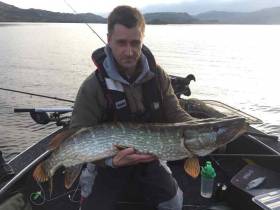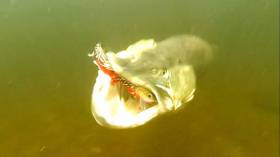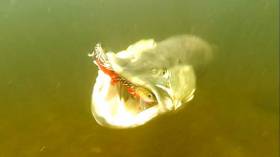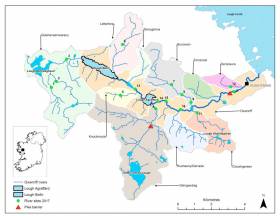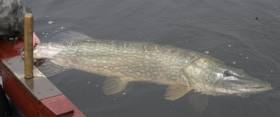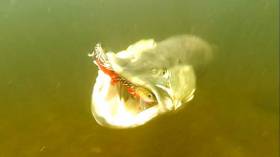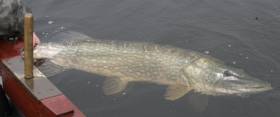Displaying items by tag: Pike
Lough Ree’s former Pike Classic has a new name and had expanded to the whole of the lake for the first time, as Shannonside News reports.
The Lough Ree International King of the Lake Festival will be fished over the weekend of 9-10 September and also promises to be one of the biggest angling events in Europe in terms of its prize pot.
It’s hoped that as many as 160 anglers from across Ireland and overseas will be attracted to Lough Ree and help revitalise tourism in the region.
Fishing will take place between the Bypass Bridge in Athlone and the lock at Tarmonbarry in Roscommon.
And the two days of competition will be preceded by an exhibition and angling show in Ballyleague on Friday 8 September.
Shannonside News has more on the story HERE.
Pike Spotted in Galway Well Prompts Subterranean Fish Life Query
County Galway reader Brenda Richardson spotted a carnivorous pike fish (above) in her (unused) well in a farm field about one mile from Lough Corrib and near Wormhole boglands and she writes:
There is a history of eel sightings in this well but we did not expect to see a fish (the pike which was about 12 inches in length.) Obviously, there are underground caverns beneath the farmland leading out to the Corrib.
The ancestors named the field near the well as Gort na hAibhne when translated is river field. However, there are no rivers in the area.
We would be interested if there are any experts with knowledge or research on subterranean fish life in Ireland.
Please send any correspondence to [email protected] for forwarding to Brenda.
Inland Fisheries Ireland (IFI) has confirmed the presence of pike in Aughrusbeg Lough in Connemara, Co Galway.
IFI research staff made the discovery during a fish stock survey earlier this week. It is the first official record of pike being present in the freshwater lake.
The State agency responsible for the protection and conservation of freshwater fish and habitats is investigating if the pike was “introduced” to the lake through human activity, by the illegal movement of fish between watercourses.
The introduction of pike to small low-complexity lakes such as Aughrusbeg Lough could be devastating to resident fish populations.
New introductions are also potentially a carrier of fish disease and parasites, the State agency has said.
IFI chief executive Francis O’Donnell said: “Ireland’s inland waterbodies are ecologically important ecosystems, which support significant recreational fisheries for native and established fish species.
“‘Introductions’ of new species threaten these ecosystems that they support, potentially in unforeseen ways, and are a major cause for concern for Inland Fisheries Ireland.”
He added: “Unfortunately, a similar introduction of pike into the upper sections of the Owenriff catchment in Co Galway over 10 years ago caused the virtual collapse of what had been a very important salmonid fishery in the West of Ireland.”
To help assess the scale of the problem, IFI researchers are currently analysing samples from the latest fish stock survey to establish the age and distribution of the pike population discovered in the lake.
In the meantime, IFI is appealing to all anglers to protect Ireland’s fisheries by not moving fish between watercourses, for any reason.
To report suspicions around the illegal movement of fish between watercourses, anglers and members of the public are encouraged to call IFI’s confidential hotline number on 1890 34 74 24, which is open 24 hours a day.
Pike Fishing Bodies Welcome High Court Annulment of Bye-Law
The Irish Pike Society (IPS) and the Irish Federation of Pike Angling Clubs (IFPAC) have welcomed the annulment by the High Court on Monday 25th February of ‘The Designated Salmonid Waters Bye-Law’, which has provided for the killing of four pike of any size per angler per day on a number of Irish waterways. The bye-law also designated such waters to be managed primarily for the benefit of salmonid species of fish.
The ruling of the High Court was in response to a challenge from the Irish Pike Society and Irish Federation of Pike Angling Clubs to the bye-law under Section 57 of the Inland Fisheries Act of 2010. The decision will be welcomed by national angling bodies, tourism organisations, and local businesses.
It was apparent from the outset that the bye-law, which allowed for the ecologically devastating depletion of Ireland’s previously statutorily protected pike population, was based on uninformed views and that there was no scientific basis for the provisions contained in it. Recent research carried out by Inland Fisheries Ireland, the statutory body for the management of Ireland’s inland fisheries, found that pike feed primarily on species other than salmonid fish.
The available scientific evidence also showed that the bye-law would in fact be hugely detrimental to salmonid stocks. A detailed report from Dr Bruno Broughton, an internationally renowned Fisheries Management Consultant, severely criticised the bye-law on a number of grounds.
Despite the defeat of the bye-law, the arguments for it, which promote the daily killing of thousands of pike in over 30% of Irish waterways, are still used to justify pike culling practices. The practice of ‘gill-netting’ is still used by Inland Fisheries Ireland to reduce pike levels. This involves thousands of meters of net being strung across shallow bays to capture and kill pike as they travel to their spawning beds.
Ian Forde, Chairman of the Irish Pike Society said: “We welcome the decision of the High Court, which is the result of a massive effort from federations, clubs and individual anglers who raised funds to mount a challenge to the bye-law by way of a statutory appeal. This is a good decision for anglers in Ireland – not only pike anglers, but also trout anglers, and the visiting tourists who spend close to €800 million every year in our economy.
However, the continued culling of pike populations is still permitted, despite a lack of current scientific research to support any argument for it. Pike anglers in Ireland implore the Government to suspend pike culling measures such as gill-netting and face the real problems concerning inland fisheries head on”.
Trout Anglers Welcome New Bye-Law For Western Lakes - But Pike Angling Group Takes Aim At Minister
#Angling - The Connacht Angling Council has welcomed the new bye-law providing special protection for wild brown trout in the great western lakes.
As previously reported on Afloat.ie, the Designated Salmonid Waters Bye-law was signed last Thursday 25 October by the new Minister for Communications, Climate Action and Environment, Richard Bruton.
It means that Loughs Carra, Conn, Cullin and Mask in Mayo, Lough Corrib in Co Galway, Lough Arrow in Cos Sligo and Roscommon, and Lough Sheelin in Westmeath, Meath, Cavan and Longford will now be managed exclusively for the benefit of wild brown trout.
“We are delighted [former Environment] Minister Kyne took on board our grave concerns regarding the future of wild brown trout stocks in western lakes,” said Martin Kinneavy, chair of the Connacht Angling Council.
"There is now a sincere and genuine commitment to develop wild brown trout stocks in western lakes and a copper-fastened strategy to deal with the threat of predator pike.
“Our world famous Irish wild brown trout fisheries are now protected by law from pike and can reach their full trout angling potential.”
A previous bye-law in relation to the protection of pike in these waters will now no longer apply – which has raised the ire of pike anglers in the affected region.
Members of the Irish Pike Society are preparing a mass protest for the constituency offices of Minister Bruton and Taoiseach Leo Varadkar as well as Leinster House.
They argue that the bye-law changes “will decimate a section of the Irish angling industry which supports over 11,000 jobs and contributes almost €1bn to the Irish economy,” according to the society’s secretary Paul Byrne.
“The Irish Pike Society have over the past months engaged legal counsel and are fully prepared to challenge Minister Bruton in the High Court,” he added.
Pike In Irish Waters Have Changed Their Diet, New Research Indicates
#Angling - Pike in Irish waters may have changed their diet preferences, according to a new report launched this week by Inland Fisheries Ireland.
The report looks at new research carried out in 2016 on Lough Conn in Co Mayo and Lough Derravaragh in Co Westmeath and provides an insight into the dietary habits of pike.
Previous dietary research carried out in the 1960s and 1970s in Lough Derravaragh and Lough Sheelin (located across Westmeath, Meath and Cavan) indicated that pike preferred to eat brown trout and perch.
However, this latest research reveals that pike appear to have changed their prey preference and now predominately eat roach.
Researchers in Scotland and England have also found similar changes in pike diet occurring in Scotland (at Loch Lomond) and England (at Lake Windermere). It is thought the changes in diet are due to the invasion of roach in these waters.
The research examines whether pike and brown trout can co-exist in the same habitat. Using statistical models, it found that the species could live together within relatively large deep lakes with strong stream connectivity. However, in small, low-complex systems, pike introductions could potentially have a devastating impact on resident brown trout populations.
The practice of pike removal and the impact it has on brown trout stocks is also examined. The findings suggest that pike removal may only be effective in protecting brown trout populations in systems where trout are the only available prey, but may have little effect in systems where other prey, such as roach, is available.
“This research was initiated to answer some ongoing questions relating to the dietary preference of pike and the pike-brown trout interactions in lakes across Ireland,” said IFI chief executive Dr Ciaran Byrne. “Previous studies in this area were carried out more than 50 years ago which is a long time within our changing lake systems.
“This research is important as it gives an insight into the behaviour of the pike species and provides updated information around their relationship with brown trout. The changing food web and altered preferences of predators in the water systems highlights the need for continued monitoring and updated data to inform effective management strategies.
“This research will now be considered alongside the many historic, socio-economic and management factors which all inform fisheries management and development work. Inland Fisheries Ireland uses the best available scientific information to underpin management decision making and advice.”
For further information visit www.fisheriesireland.ie/pikeresearch.
Plan Published For Recovery Of Salmon & Trout Stocks In Owenriff Catchment
#Angling - Inland Fisheries Ireland has published its 2017 fish stock survey for the Owenriff catchment as well as its rehabilitation plan for the system to promote the recovery of brown trout and salmon in its lakes and rivers.
The Fish Stock Survey — which was conducted in the summer of 2017 and forms the basis for the Rehabilitation Plan — deduces that the introduction of pike into the catchment has been the significant factor in the declining fish stocks.
“As there are little or no major anthropogenic pressures in the catchment to cause the decline in fish stocks, it is reasonable to infer that the introduction of pike and their subsequent range expansion in the Owenriff catchment (with impacts of competition for food and space and predation on resident and migratory fish) is the main factor causing the decline of brown trout and salmon in the Owenriff catchment. Research from Europe and North America supports this finding,” the reports states.
Anthropogenic pressures include human-induced factors such as urban growth, deleterious discharges, farming activities and introduction of alien species.
Although pike were captured for the first time by IFI staff in 2009 in two lakes in the catchment (Loughs Bofin and Agraffard) and efforts were made by IFI staff to remove the pike from the system, they did not show up in two catchment-wide surveys in 1997 and 2007 and were only officially recorded in a survey for the first time in 2015.
However, the latest report, from the 2017 survey, confirms that pike are present all over the Owenriff catchment “in areas where they can freely gain access and in some areas where they cannot naturally gain access.”
Welcoming the publication of the two reports, Minister Sean Kyne TD said: “We have acted swiftly since the interim results of this survey became known. In late January, I announced that Inland Fisheries Ireland is to commence fish stock management operations on the Owenriff catchment to protect and restore trout stocks which have been impacted by recent introductions of pike to the catchment.
“The consequences of not taking wider remedial action on the basis of these survey results would lead to further decline in ecological biodiversity in the catchment, so I very much welcome the publication by IFI of the Owenriff Fish Population Rehabilitation Plan 2018.”
The minister continued: “The purpose of the plan is to develop a fisheries rehabilitation project that can be undertaken on the catchment to promote the recovery of the brown trout (both resident and migratory Corrib) and salmon populations in both lakes and rivers. It will take time and will be costly, but we are already underway with this very constructive and positive roadmap.”
With stock management actions having already commenced, the success of the broader rehabilitation project will depend on applying the correct tools to rehabilitate the brown trout and salmon populations in the Owenriff catchment.
These include fisheries enhancement works in selected sub-catchments to favour brown trout and salmon; genetic restoration; removing the problem (pike control); reducing anthropogenic impacts in the catchment; public awareness (especially in relation to the impacts of the introductions of species not indigenous to an area); interagency co-ordination; climate change mitigation; and any other necessary measures.
The Owenriff catchment is located on the north-western end of the Lough Corrib catchment, and the main Owenriff River drains into Lough Corrib Upper downstream of Oughterard, Co Galway. The Lough Corrib catchment itself is the largest and most important wild salmonid catchment in Ireland, and Lough Corrib is considered the premier wild brown trout fishery in Ireland.
The Owenriff rehabilitation plan and 2017 fish stock survey can both be downloaded from the IFI website. Afloat.ie also has more on IFI's stock management plan for Ireland's trout waters in 2018.
Fish Stock Management Plan Launched For Owenriff Catchment
#Angling - Sean Kyne, Minister of State with responsibility for the inland fisheries sector, has announced that Inland Fisheries Ireland will shortly commence fish stock management operations on the Owenriff catchment near Oughterard in Co Galway.
The measures to protect and restore trout stocks, which have been impacted by recent introductions of pike to the catchment, were promised last November upon the development by IFI of a specific stock management plan.
“The Owenriff catchment is one of the most important spawning and nursery tributaries of Lough Corrib, our most renowned wild trout fishery,” said Minister Kyne as he made the announcement today (Monday 29 January).
“Previous scientific studies have shown it contributed 15% of the wild trout found in Lough Corrib, and each year thousands of wild trout and salmon migrate upstream into the Owenriff to spawn.
“I am committed to protecting and rehabilitating the system and welcome IFI’s stock management plan which I have asked to be implemented immediately.”
IFI will be commencing a focused and intensive effort aimed at reducing the numbers of pike in the Owenriff catchment over the coming year.
While pike cannot be completely eradicated, the project will reduce numbers to a level where they are not impacting significantly on salmonid stocks.
It is expected that ongoing maintenance operations will be required in future years to help maintain the trout population.
Minister Kyne also emphasised that, in tandem with the stock management plan, IFI is also preparing an Owenriff Fish Population Rehabilitation Plan which aims to ensure trout stocks and habitats are restored and protected, thereby providing the best opportunities for a successful trout population. The plan will be available shortly.
Survey results are currently being compiled and will be available from the IFI website. Further information on the stock management plan is available HERE.
Minister Welcomes Stock Management Plan & Survey For Lough Corrib Tributary
#Angling - Sean Kyne, Minister with responsibility for Inland Fisheries, has welcomed the development by Inland Fisheries Ireland (IFI) of a specific stock management plan for Galway’s Owenriff system aimed at removing pike from the system as a significant step forward.
Stock management operations are normally commenced in February each year and the Owenriff plan will be implemented for 2018.
Minister Kyne said: “I met recently with the board and senior management of Inland Fisheries Ireland to discuss this, and other issues, and it has now been agreed that, in line with current policy, a stock management plan explicitly for the Owenriff will be implemented in a more intensive focus on the system to facilitate the recovery of the salmonid populations.
“It has also been agreed that IFI will continue to implement a stock management programme for the entire Corrib catchment, in line with its current policy,” he added.
The minister also welcomed confirmation by IFI that the results of a fish population survey of the Owenriff system, which was undertaken during the summer of 2017, will be reported on in January 2018.
Dr Cathal Gallagher, head of research and development at IFI, said: “We have listened to local stakeholders and staff in relation to threats posed to salmon and trout populations in the Owenriff, a tributary of Lough Corrib.
“To understand the scale of the issues reported and to support evidence-based management, Inland Fisheries Ireland conducted a fish population survey in late June and late July 2017. We have since worked in the laboratory and with relevant analytical tools to understand the dynamics of the fish stocks in this catchment.
“We have also reviewed mitigation actions that could be taken to restore damage incurred by specific stocks. A proposed rehabilitation plan for the system will be delivered in parallel to the fish stock survey report.”
As part of its research into fish population in the Owenriff system, IFI surveyed 17 river sites and two lakes using standard fish population sampling methods.
IFI staff are currently analysing the data and comparing it to data from previous surveys and neighbouring catchments to determine the status of the fish stocks and to assess change.
A fish stock survey report, which will be available in January, will document important metrics including fish species richness, fish abundance, length frequency, age and growth, and fish ecological status.
Supported by analysis of the survey results, and taking account of the ecology of specific systems, IFI says it will deliver a detailed plan which will focus on the rehabilitation of endangered fish populations in this important catchment.
This will include plans to maintain the genetic diversity of salmon and trout stocks in the Owenriff catchment.
Anglers Already Involved With Review Of Pike In Brown Trout Fisheries, Says IFI
#Angling - Inland Fisheries Ireland (IFI) has spoken out over anglers' fears of the threat of pike to wild brown trout numbers.
Earlier this week, the Connacht Angling Council launched a campaign and online petition in an effort to provoke action its members argue is necessary to protect brown trout numbers from “predator” pike in Lough Corrib, Lough Mask and other lakes in the region.
However, in a statement released yesterday (Thursday 21 September), IFI said it was “regrettable that stakeholder groups are campaigning and taking unilateral action”.
The fisheries body argues that the main representative groups for both trout and pike angling are “already part of the inclusive review process”, and gave oral submissions earlier this year as part of last winter’s public consultation on pike management in wild brown trout fisheries, as previously reported on Afloat.ie.
“At this time, no conclusions or recommendations have been made. It is important that the [Management of Pike in Designated Wild Brown Trout Fisheries Policy] Review Group, with inputs from all stakeholders, is facilitated in completing its work,” the statement added.
“Given the strongly held views of the two angling stakeholder groups involved, trout anglers and pike anglers, it is IFI’s view that consensus will only be achieved if representatives from both groups participate in a constructive and respectful way in the current process, and away from mainstream and social media.”



























